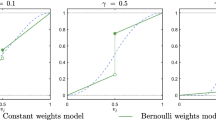Abstract
Auctions that select core allocations with respect to reported values generate competitive levels of sales revenues at equilibrium and limit bidder incentives to use shills. Among core-selecting auctions, the ones that minimize seller revenues also maximize incentives for truthful reporting, produce the Vickrey outcome when that lies in the core and, in contrast to the Vickrey auction, and create no incentive for a seller to exclude qualified bidders. Core-selecting auctions are related to and share properties with stable matching mechanisms.
Similar content being viewed by others
References
Abdulkadiroglu A, Pathak P, Roth A, Sonmez T (2005) The Boston Public School Match. In: AEA papers and proceedings, pp 368–371
Ausubel L, Milgrom P (2002) Ascending auctions with package bidding. Front Theor Econ 1(1), Article 1
Ausubel L, Milgrom P (2005) The lovely but lonely vickrey auction. In: Cramton P, Shoham Y, Steinberg R (eds) Combinatorial auctions. MIT Press, Cambridge
Bernheim BD, Whinston M (1986) Menu auctions, resource allocation and economic influence. Q J Econ 101:1–31
Bertrand J (1883) Théorie Mathématique de la Richesse Sociale. J des Savants 69:499–508
Day RW, Raghavan S (2006) Fair payments for efficient allocations in public sector combinatorial auctions. Manag Sci (Forthcoming)
Green J, Laffont J-J (1979) Incentives in public decision making. North Holland, Amsterdam
Hatfield J, Milgrom P (2005) Matching with contracts. Am Econ Rev 95(4):913–935
Holmstrom B (1979) Groves schemes on restricted domains. Econometrica 47:1137–1144
Kagel J, Roth A (2000) The dynamics of reorganization in matching markets: a laboratory experiment motivated by a natural experiment. Q J Econ:201–235
Kelso A, Crawford V (1982) Job matching, coalition formation, and gross substitutes. Econometrica 50:1483–1504
McMillan J (1994) Selling spectrum rights. J Econ Perspect 8:145–162
Milgrom P (2004) Putting auction theory to work. Cambridge University Press, Cambridge
Milgrom P (2006) Incentives in core-selecting auctions. Stanford University
Parkes D, Ungar L (2000) Iterative combinatorial auctions: theory and practice. In: Proceedings of the 17th national conference on artificial intelligence, pp 74–81
Reny P (1999) On the existence of pure and mixed strategy nash equilibria in discontinuous games. Econometrica 67(5):1029–1056
Roberts J, Postlewaite A (1976) The incentives for price-taking behavior in large exchange economies. Econometrica 44(1):115–129
Roth AE (1982) The economics of matching: stability and incentives. Math Oper Res 7:617–628
Roth AE, Peranson E (1999) The redesign of the matching market for American physicians: some engineering aspects of economic design. Am Econ Rev 89:748–780
Roth AE, Sotomayor M (1990) Two-sided matching: a study in game-theoretic modeling and analysis. Cambridge University Press, Cambridge
Roth AE, Xing X (1994) Jumping the gun: imperfections and institutions related to the timing of market transactions. Am Econ Rev 84:992–1044
Segal I (2003) The communication requirements of combinatorial auctions. In: Cramton P, Shoham Y, Steinberg R (eds) Combinatorial Auctions. Princeton University Press, Princeton
Simon LK, Zame WR (1990) Discontinuous games and endogenous sharing rules. Econometrica 58: 861–872
Yokoo M, Sakurai Y, Matsubara S (2004) The effect of false-name bids in combinatorial auctions: new fraud in internet auctions. Games Econ Behav 46(1):174–188
Author information
Authors and Affiliations
Corresponding author
Additional information
This paper evolved from Milgrom (2006), which reported a portion of Milgrom’s Clarendon lectures for 2005. The authors subsequently discovered that versions of what is here Theorem 3 appeared both in that paper and one produced independently by Day and Raghavan (2006). We have collaborated on this revision; in particular, nearly all of the material on shill bidding is new.
Milgrom received financial support for this research from National Science Foundation under grant ITR-0427770. We thank Roger Myerson for suggesting the connection to Howard Raiffa’s observations about bargaining, Yeon-Koo Che for comments on an earlier draft, and Manuj Garg for proofreading.
Rights and permissions
About this article
Cite this article
Day, R., Milgrom, P. Core-selecting package auctions. Int J Game Theory 36, 393–407 (2008). https://doi.org/10.1007/s00182-007-0100-7
Accepted:
Published:
Issue Date:
DOI: https://doi.org/10.1007/s00182-007-0100-7
Keywords
- Core
- Stable matching
- Marriage problem
- Auctions
- Core-selecting auctions
- Menu auctions
- Proxy auctions
- Package bidding
- Combinatorial bidding
- Incentives
- Truncation strategies




